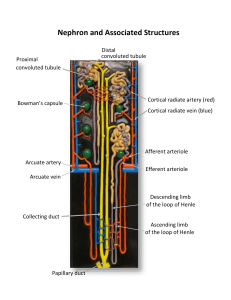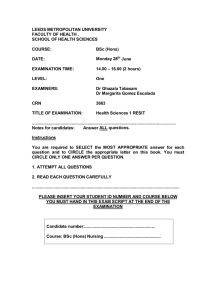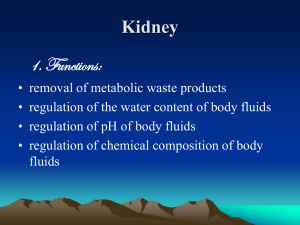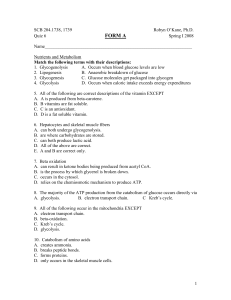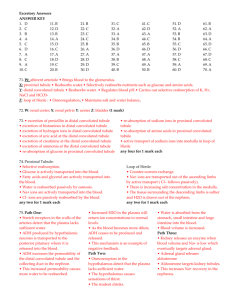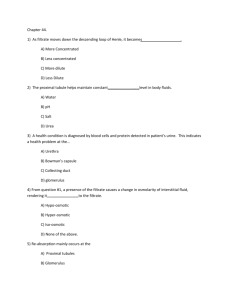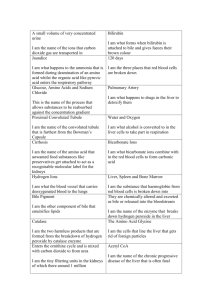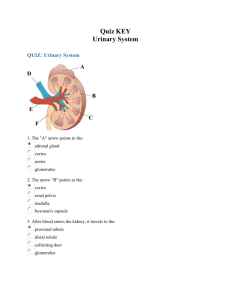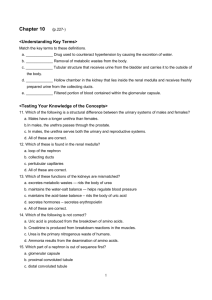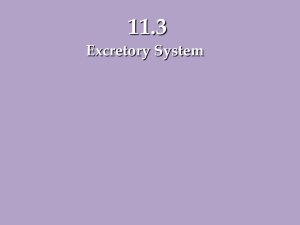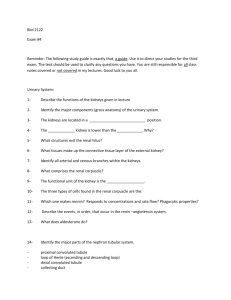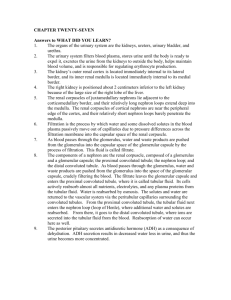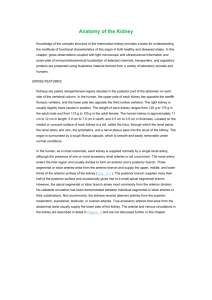Physiology_for Osteopathy_MAY_2010_Mod3377
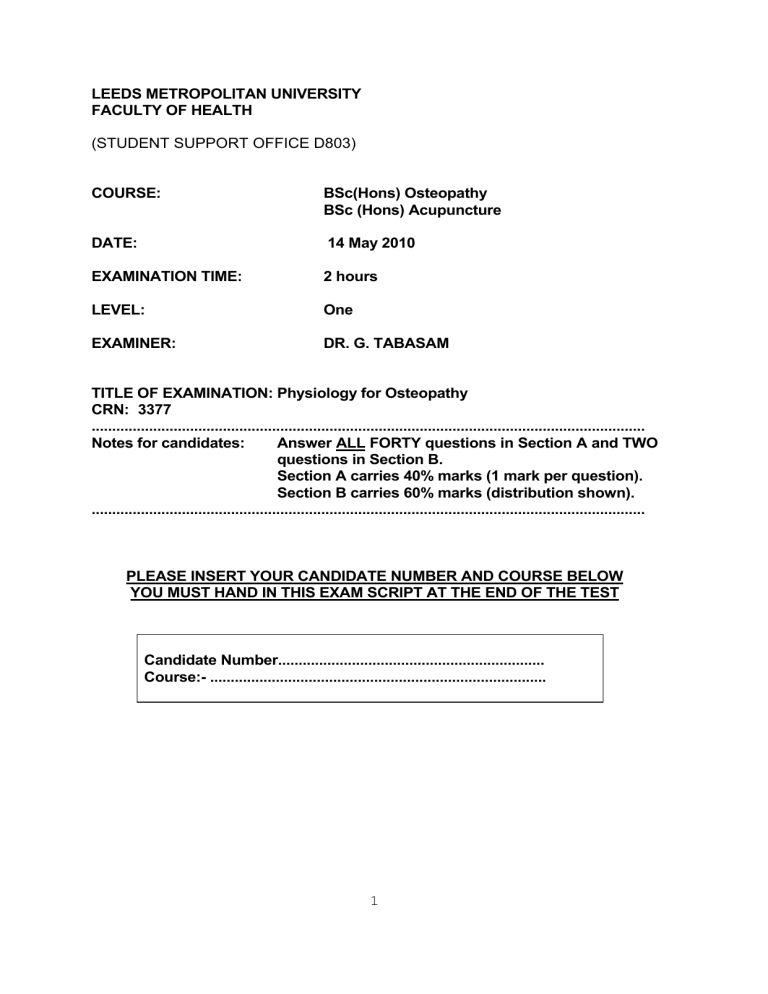
LEEDS METROPOLITAN UNIVERSITY
FACULTY OF HEALTH
(STUDENT SUPPORT OFFICE D803)
COURSE:
DATE:
EXAMINATION TIME:
LEVEL:
EXAMINER:
BSc(Hons) Osteopathy
BSc (Hons) Acupuncture
14 May 2010
2 hours
One
DR. G. TABASAM
TITLE OF EXAMINATION: Physiology for Osteopathy
CRN: 3377
.......................................................................................................................................
Notes for candidates: Answer ALL FORTY questions in Section A and TWO questions in Section B.
Section A carries 40% marks (1 mark per question).
Section B carries 60% marks (distribution shown).
.......................................................................................................................................
PLEASE INSERT YOUR CANDIDATE NUMBER AND COURSE BELOW
YOU MUST HAND IN THIS EXAM SCRIPT AT THE END OF THE TEST
Candidate Number.................................................................
Course:- ..................................................................................
1
Section A - Instructions
You are required to SELECT the MOST APPROPRIATE answer for each question and to CIRCLE the appropriate letter in this book. You must CIRCLE ONLY ONE
ANSWER PER QUESTION.
Your answers should also be recorded on an optical mark reader score sheet
(EDPAC - pink form) as follows;
Using an HB PENCIL strike through the letter (A,B,C, D or E) that indicates the answer you think is correct as shown below:
[ D ] [ E ] [ A ] [ B ] [ C ]
Do NOT mark any part of the form like this [ A ] or [ A ] or [ A ]
If you wish to change an answer use a pencil eraser to completely remove the incorrect mark.
It is important that you do not "dirty" the score sheet with stray marks.
DO NOT FOLD THE SCORE SHEET.
To add your personal details to the EDPAC (pink) form
1. Insert the letters of your surname into the Candidate name box and strike out the corresponding letters (A, B, C, D or E) in the column below
2. Insert your student id into the Candidate number box and strike out the corresponding numbers.
3. Insert the Subject code 001 into the Subject number box and strike out the corresponding numbers ( 001 ) in the column below -all candidates have the same subject code
4. Write the name of your degree course (e.g. Human Biology) into the Subject box.
5. An example of a completed EDPAC sheet is provided at the end of this paper.
2
SECTION A Answer ALL FORTY questions (40 minutes).
INSTRUCTIONS
Choose the ONE alternative that best completes the statement or answers the question. CIRCLE the appropriate letter on this sheet.
REMEMBER TO TRANSFER YOUR ANSWERS TO THE OPTICAL MARK
READER SHEET (THE PINK EDPAC SHEET)
1. The correct sequence for a reflex arc is: 1 = post-ganglionic neuron, 2
= receptor, 3 = effector, 4 = control center, 5 = afferent neuron, 6 = pre-ganglionic neuron
A) 2, 5, 4, 1, 3, 6
B) 1, 5, 4, 2, 6, 3
C) 5, 1, 3, 2, 4, 6
D) 2, 5, 4, 6, 1, 3
E) 2, 5, 3, 1, 6, 4
2. If a response decreases the original stimulus, the system is classified as a ___________ feedback system:
A) positive
B) polarised
C) negated
D) neutral
E) negative
3. Which of the following is paired CORRECTLY?
A) thermoreceptors – help to produce taste
B) chemoreceptors - detect blood pressure
C) mechanoreceptors – help to produce proprioception
D) photoreceptors – help to produce photons
E) nociceptors – cause tissue damage
4. Which of the following is TRUE?
A) there is 2 pairs of coccygeal spinal nerves
B) there are 8 pairs of cervical spinal nerves
C) there are 3 pairs of sacral spinal nerves
D) there are 10 pairs of thoracic spinal nerves
E) there are 8 pairs of lumbar spinal nerves
3
5. The most important factors that determine the speed of nerve impulse
propagation are:
A) the number of dendrites and the presence or absence of the
myelin sheath
B) fiber diameter and presence or absence of myelin sheath
C) the strength of the stimulus and the potassium level present in
the axon
D) the level of the spinal cord nerve and the nerve fiber's
diameter
E) the strength of the stimulus and the sodium level present
6. The integrating centre which controls a feedback loop is typically sited
within the:
A) nervous system
B) endocrine system
C) cardiovascular system
D) respiratory system
E) gastrointestinal system
7. Which of the following statements is FALSE?
A) electrical inhibition of a cell membrane is termed hyperpolarisation
B) stimulus intensity is coded by the frequency (rate) of action
potentials
C) a traveling action potential is called an impulse
D) fibers with larger diameters conduct impulses slower than fibers with smaller diameters
E) myelinated fibers conduct impulses faster than unmyelinated
fibers
8. The release of neurotransmitter at a synapse is triggered by the entry
of which ion into the presynaptic nerve terminal?
A) chloride
B) sodium
C) potassium
D) calcium
E) lithium
4
9. Which of the following is true regarding neurotransmitters?
A) neurotransmitters are released by glands and transported in the
blood to their target tissue
B) excitatory neurotransmitters activate the post synaptic neuron by
travelling through ionic channels
C) neurotransmitters can be washed away from the synaptic cleft by
the blood
D) neurotransmitters can be actively transported back into the
neuron that released them
E) neurotransmitters remain in the synaptic cleft for many weeks
10. Which of the following is characteristic of the parasympathetic
nervous system?
A) heart rate increases
B) liver stores glucose
C) bronchioles dilate
D) pupils dilate
E) blood pressure increases
11. Which of the following are characteristic of synaptic function?
A) The synapse is the functional unit of integration in the nervous
system
B) Action potentials can be transmitted in either direction at a synapse
C) Excitatory post synaptic potentials (EPSPs) cannot undergo spatial
summation because during EPSP the membrane is absolutely
refractory to a second stimulus
D) Release of an inhibitory transmitter agent from a presynaptic
terminal will lead to a depolarization of the postsynaptic cell
membrane
E) Inhibitory postsynaptic potentials (IPSPs) inhibit the release of
excitatory transmitter agents from presynaptic terminals
12. Heart rate is predominantly monitored and regulated in the:
A) medulla
B) respiratory centre
C) pons
D) thalamus
E) spinal cord
5
13. Which cell type lack a nucleus, cannot reproduce and consist of a
"Biconcave disk shape" that is only 7.5
µ m wide?
A) monocytes
B) leukocytes
C) lymphocytes
D) erythrocytes
E) thrombocytes
14. The type of granulocyte called neutrophils are:
A) phagocytic
B) found to have many lobed nuclei (polymorphonuclear)
C) the most numerous leukocytes in the blood
D) known to develop in bone marrow
E) all of the above
15. As a result of ventricular relaxation, there is a force in
which blood pushes against arterial walls. This force is called:
A) systolic blood pressure
B) pulmonary blood pressure
C) diastolic blood pressure
D) venous pressure
E) synaptic blood pressure
16. Haemopoiesis may be best described as:
A) filtering of the blood cells
B) the examination of erythrocytes
C) plasma separation
D) formation of blood cells
E) blood cell mitosis
17. The type of circulation that carries blood from the lungs to the heart
is referred to as:
A) systemic circulation
B) systematic circulation
C) respiratory circulation
D) pulmonary circulation
E) hepatic portal circulation
6
18. Which blood cells are formed from fragmentation of
metamegakaryocytes?
A) lymphocytes
B) monocytes
C) thrombocytes
D) eosinophils
E) erythrocytes
19. White blood cells constitute about ________ of the blood volume.
A) 1%
B) 80%
C) 25%
D) 45%
E) 150%
20. The outermost layer of the heart is called the :
A) epicardium
B) endocardium
C) myocardium
D) myocardial cortex
E) visceral pericardium
21. The delay in spread of the cardiac action potential from the atria to
the ventricles is imposed by the:
A) atrioventricular node
B) sinoatrial node
C) septum
D) purkinje fibres
E) bundle of His
22. Which of the following valves function in preventing the backward
flow of blood from the right ventricle into the right atrium?
A) mitral valve
B) bicuspid valve
C) tricuspid valve
D) aortic semilunar valve
E) pulmonary semilunar valve
7
23. Pulmonary ventilation may be best defined as the:
A) taking of air in through the nose
B) exchange of gases between the atmosphere, blood and cells
C) exchange of gases between the lungs and the atmosphere
D) taking oxygen into and out of the blood
E) exchange of gases between the alveoli and the blood
24. Air moves out of the lungs when the pressure inside the lungs is:
A) less than the pressure in the atmosphere
B) greater than the pressure in the atmosphere
C) equal to the pressure in the atmosphere
D) less than intrapulmonic pressure
E) greater than intraalveolar pressure
25. Which stimuli predominantly drive the desire to breathe?
A) increase in sodium ions in the blood
B) increase in partial pressure of oxygen and carbon dioxide
C) build up of oxygen in the body and increase in hydrogen ions
D) build up of potassium ions in the blood
E) increase in partial pressure of carbon dioxide
26. In respiratory physiology, the term ‘compliance’ refers to:
A) The ease with which the lungs and thoracic wall can be expanded
B) The volume of gas left in the lungs following a maximal expiration
C) The rate at which the lungs can be inflated/deflated
D) The adherence of the pleural membranes
E) The route via which gases travel from the atmosphere into the alveoli
27. A part of the nervous system that coordinates the transition
between inspiration and expiration by sending impulses to the
inspiratory area that activates it and prolongs inspiration,
thus inhibiting expiration is called:
A) the medullary rhythmicity area – inspiratory area
B) the apneustic area in the pons
C) the pneumotaxic area in the pons
D) the vomitting centre
E) the medullary rhythmicity area – expiratory area
8
28. Pain can best be defined as:
A) a sensory experience that is ALWAYS produced by tissue
damage
B) a sensation that produces a withdrawal (flexor) reflex
C) an unpleasant sensory and emotional experience associated
with tissue damage
D) an emotional experience associated with unpleasant situations
E) none of the above
29. The two tracts involved in the transmission of noxious information
are:
A) reticulospinal and thalamospinal
B) corticospinal and spinoreticular
C) corticospinal and thalamospinal
D) spinothalamic and corticospinal
E) spinothalamic and spinoreticular
30. Nociceptors:
A) are preferentially sensitive to tissue damage
B) are preferentially sensitive to thermal stimuli
C) when activated always produce a sensation of pain
D) are preferentially sensitive to non-noxious stimuli
E) are preferentially sensitive to mechanical stimuli
31. The 'pain gate':
A) when closed increases the experience of pain
B) is formed by the synaptic connections between neurons
C) is located in the nociceptors
D) can be opened by rubbing the skin
E) utilises aspirin as its neurotransmitter
32. Which of the following is NOT a feature of the small intestine which aids
in the absorption of nutrients from the gut:
A) large surface area
B) possession of a lacteal for fat absorption
C) good blood supply
D) very thick membrane
E) all of the above are features the aid absorption
9
33. Functions of the kidney include all of the following except:
A) regulation of blood pressure
B) regulation of blood ionic composition
C) regulation of blood pH
D) removal of metabolic waste products (with the exception of
carbon dioxide) from the body
E) removal of old red blood cells from the circulation
34. The correct order for the flow of filtrate through the kidney
tubule is:
A) bowmans capsule, loop of henle, proximal convoluted tubule,
distal convoluted tubule, collecting duct
B) bowmans capsule, distal convoluted tubule, loop of henle, distal
convoluted tubule, collecting duct
C) bowmans capsule, proximal convoluted tubule, distal
convoluted tubule, collecting duct, loop of henle
D) bowmans capsule, proximal convoluted tubule, loop of henle,
distal convoluted tubule, collecting duct
E) bowmans capsule, proximal convoluted tubule, collecting duct,
distal convoluted tubule, loop of henle
35. Which of the following is true about antidiuretic hormone (ADH)?
A) its target organ is the heart.
B) alcohol stimulates ADH secretion.
C) ADH is released during dehydration and it closes water
channels in the collecting duct of the nephron
D) it is also called vasopressin.
E) the secretion of ADH increases when you drink 1 litre of water.
36. Water reabsorption in the kidney:
A) is linked to the reabsorption of solutes from the filtrate
B) does not involve aquaporins
C) is a primary active transport process
D) is 100% facultative (regulated)
E) is under the control of the hormone oxytocin
10
37. Nerve impulses from the hypothalamus directly stimulate release of
hormones from the:
A) anterior pituitary gland only
B) posterior pituitary gland only
C) thyroid gland
D) adrenal cortex
E) both the anterior and posterior pituitary gland
38. Which system is composed of a series of glands that
secrete hormones.
A) cardiovascular
B) endocrine
C) gastrointestinal
D) urinary
E) respiratory
39. Digestive enzymes;
A) slow down chemical reactions in the gastrointestinal tract
B) slow down gastrointestinal tract motility
C) speed up gastrointestinal tract motility
D) speed up chemical reactions in the gastrointestinal tract
E) both answers C and D are correct
40. Homeostasis refers to the:-
A) stoppage of bleeding
B) formation of blood cells
C) maintenance of the body
D) maintenance of blood cells
E) constant conditions in the internal environment of the body
REMEMBER TO TRANSFER YOUR ANSWERS TO THE
OPTICAL MARK READER SHEET (THE PINK EDPAC SHEET)
11
SECTION B Answer TWO TWO-PART questions from this section (80 minutes).
Each question is worth 30 marks (15 marks for part a and 15 marks for part b).
1. a) List the sequence of events which occur during transmission of
information across a chemical synapse. b) Describe the regulation of the partial pressure of carbon dioxide by the
respiratory system by explaining the physiological events which occur
when you try to hold your breath indefinitely. (You may draw a flow
chart if you wish).
2. a) Describe the sequence of electrical events that occur during the cardiac
cycle and explain the relationship between the electrical excitation of
the heart and the mechanical events during the cardiac cycle. b) Draw a simple flow chart to show the sequence of events which occur
during the withdrawal reflex.
3). a) Describe the physiological process involved in generating pain
sensations when you accidentally hit your hand with a hammer.
b) Draw a detailed flow diagram to show the nervous control of blood
pressure when a person moves from a lying to a standing position.
Include in your answer the components of the reflex arc.
4. a) Describe how antidiuretic hormone (ADH) regulates water balance
when a person quickly drinks one litre of water? (You may draw a
flowchart if you wish). b) Describe the physiological and mechanical processes involved in
pulmonary ventilation.
5. a) Draw a flow chart to show how the activity of the thyroid gland is
regulated by the hypothalamus. b) Describe the process which occur in the kidney to
regulate fluid and electrolyte balance in the body.
6 a) Describe the structures that make up the digestive
system and explain the main role of each component.
b) Describe the function of the cellular components of the blood and
explain their role in maintaining homeostasis.
12
13
